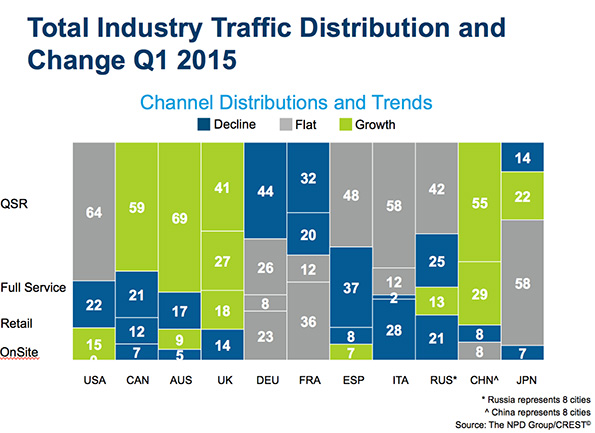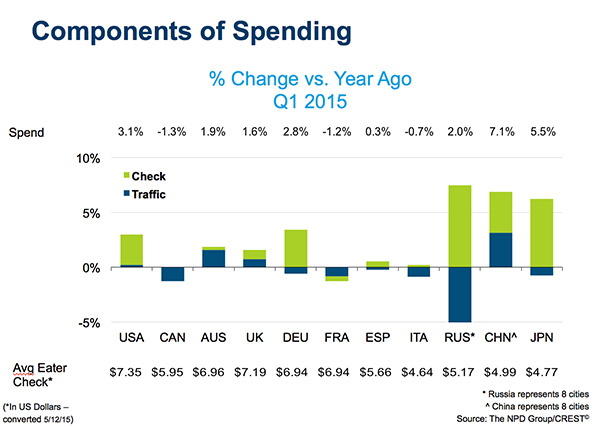The global restaurant market continues to be challenging, as the foodservice industry experiences a hesitating economic recovery, according to officials at The NPD Group.
According to the latest research from the Port Washington, N.Y.-based market research firm, consumer visits to restaurants have declined in all but a few countries. Only Australia, the United Kingdom, China and the U.S. posted positive traffic in the first quarter of 2015, compared with the previous year.
China grew traffic most, increasing about 3 percent, followed by Australia, with nearly 2-percent growth, and the United Kingdom, with 1-percent growth. Traffic in the U.S. rose less than 1 percent. Russia posted the steepest traffic decline, dropping 5 percent.
Positive traffic growth in Australia, the United Kingdom, China and the U.S. is coming from a variety of restaurant segments, NPD found. Quick service is driving growth in the United Kingdom, Australia and China. In the U.S., growth is largely coming from retail and onsite concepts.
Growth during the lunch daypart seemed to unite the strongest-performing countries, NPD found.

“Lunch is the engine,” said Bob O’Brien, global foodservice analyst for NPD. “If it’s not driving it, you can’t say it’s a healthy industry.”
Indeed, Australia, the United Kingdom and China — the countries with the strongest restaurant industries — all grew traffic at lunch. The only other country to see lunch traffic rise was Canada, but overall traffic there declined. Meanwhile, the modest overall traffic growth in the U.S. came primarily from breakfast; lunch was weak.
Lunch traffic is ultimately tied to employment, O’Brien said. Countries that currently have high unemployment, such as Spain and France, tend to not be growing lunch traffic.
Although the unemployment rate continues to decline in the U.S., O’Brien attributed the nation’s weak lunch traffic to the continued recovery from the recession and this year’s extreme winter weather.
Lunch bunch
Restaurants across the country have been paying more attention to the midday meal by re-engineering menus, adding lunch offerings for the first time, launching new marketing initiatives and more. McAlister’s Deli and Buffalo Wild Wings, two successful brands, share their efforts to capture more visits during this important and highly competitive daypart.

Making bold moves
McAlister’s Deli
When you want to drive traffic, sometimes you have to make a big, bold move. That’s what Alpharetta, Ga.-based McAlister’s Deli did in November 2013, with the launch of its Big and Bold Sandwiches, half a dozen upgraded sandwiches that are bigger or bolder in flavor than previous versions. As a result, lunch traffic has risen at the more than 300-unit fast-casual chain.
“It re-invigorated lunch,” said Donna Josephson, McAlister’s chief marketing officer. “It started to drive, add traffic.”
Among the upgraded sandwiches in the line are The New Yorker, made with double the meat of the previous iteration, including 10 ounces of corned beef and pastrami with Swiss cheese and spicy brown mustard on rye; and The Italian, made with Black Forest ham and salami, provolone cheese, lettuce, tomatoes, red onions, tri-colored bell peppers, black olives, Italian vinaigrette, salt, pepper and spicy brown mustard on a toasted baguette.
The chain’s recently introduced flavored teas and lemonades have also helped boost lunch business and average sales, Josephson said.
While Josephson credits the new menu items, she says that overall it’s the offering of more options and more ways to interact with McAlister’s on any particular day that is resonating with customers.
“The positioning of the brand and the service model has always been there,” Josephson said. “It just resonates with guests and their lifestyle right now.”
Buffalo Wild Wings
Over the years, Minneapolis-based Buffalo Wild Wings has experimented with lunch in different regions or at various franchises, with varying degrees of success.
The casual-dining chain never seemed to find the right fit to roll lunch out systemwide, until recently. Last April, the chain best known for serving up wings amid big-screen TVs launched B-Dubs Fast Break Lunch, its first-ever systemwide lunch program.
“We’re seeing a lift in lunch sales, stronger than expected,” said Todd Kronenbusch, Buffalo Wild Wings vice president of innovation. “[We’re] hoping it will be sustainable.”
The new program offers customers a choice of seven entrées and seven side dishes, as well as a handful of add-ons that show the brand can offer more than wings.
The menu includes entrées such as a Garden Salad with Chicken, Southwest Prime Rib and Slammers, mini cheeseburger or pork sandwiches, as well as sides such as French fries, chicken tortilla soup, and chips and salsa. Priced starting around $5.99 and with guests able to order, eat and go in about 40 minutes, Kronenbusch said the program satisfies consumers’ need for flavor, speed and value.
But for Buffalo Wild Wings, lunch is more than a way to drive traffic and increase sales midday.
“While the percentage of sales isn’t as great as dinner for us, [lunch] is extremely important,” Kronenbusch said. “Lunch is an opportunity for our customers to use us more than once … to build additional users in our brand.”
This story has been revised to reflect the following correction:
Correction: July 1, 2015 An earlier version of this story incorrectly characterized Buffalo Wild Wings' B-Dubs Fast Break Lunch service. Customers are able to order, eat and go in about 40 minutes.





